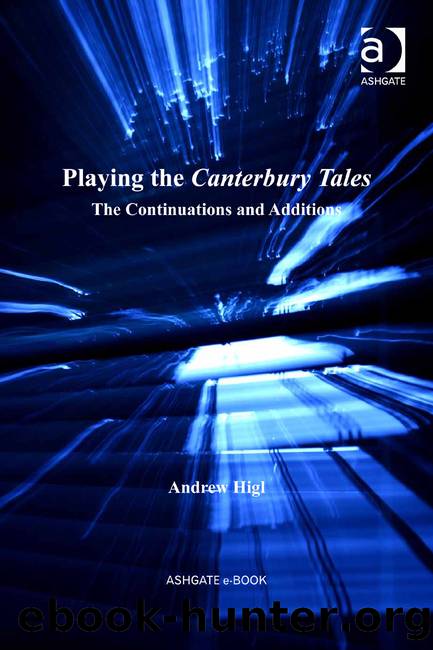Playing the Canterbury Tales by Higl Andrew;

Author:Higl, Andrew;
Language: eng
Format: epub
Publisher: Taylor and Francis
Published: 2012-08-14T16:00:00+00:00
Chapter 6
Playing Games with the Plowmen
There are several pieces on a chessboard representative of the three estates of medieval society: those who fight (i.e., the king, the knights, and perhaps even the queen), those who pray (i.e., the bishops), and those who work (i.e., the pawns).1 The pawns, though, present a particularly strange etymological problem and make isolating a societal equivalent difficult. The English term pawn derives from the Anglo-Norman poun. Poun developed from the French term pion. All of these terms derive from the Latin pedes meaning “foot soldier.” In non-Romance languages the term is often very different. In the German language, the word for pawn is bauer, which in many cases is best translated as a “farmer” or more generally “peasant.” Bauer is a term very different from our English pawn but opens a useful metaphor in understanding the social function of Chaucer’s own farmer, the Plowman.
I contend that the Plowman, the pawn in a social-text game played out in textual transmission, functions as one of the most dynamic ideological and narratological game pieces in the Canterbury Tales’ interactive textual tradition, wearing different identities in different centuries closely linked by readers historically to the author, Chaucer, himself. The silence of the Plowman in the canonical text, after the initial portrait in the General Prologue, is a point at which others began to interact with the Tales, including the orthodox Ploughman’s Tale and the proto-Protestant Plowman’s Tale. Through these interactions, “involved” readers socially produced, in the words of Nick Montfort, “a profound and responsive type of systematic world.”2 Further, the Plowman’s various manifestations extend the language of game and contestation in one case, and reshape and suppress it in another. In the introduction to the facsimile of the Hengwrt manuscript of the Canterbury Tales, Donald Baker states that “each century has had its own Chaucer.”3 I argue that each era since Chaucer’s death has had its own Plowman. Through the Plowman, writers and readers interacted with the Canterbury Tales through two new tales, one orthodox and one proto-Protestant, in order to create a new narrative path for the Tales with clear religious and sociological ideologies in play. The gap that Chaucer leaves where the Plowman’s Tale should be becomes the locus for further textual acts that seriously play with the identity of the Plowman, the Tales as a work, and the author himself.
Beyond the borders of the Canterbury Tales’ canon, the plowman was a common figure in the late medieval literary and popular religious imagination. The vast number and variety of textual instantiations of the Vision of Piers Plowman and the multifarious other literary incarnations of the plowman suggest that this figure was a prevalent medieval image of the ideal, post-lapsarian man digging and delving and often associated with English reform movements of the fourteenth and fifteenth centuries.4 Piers, the most famous of the plowmen, plows the half acre in Passus VI of the Vision of Piers Plowman, but he is also a pilgrim like the Plowman of Chaucer’s company.
Download
This site does not store any files on its server. We only index and link to content provided by other sites. Please contact the content providers to delete copyright contents if any and email us, we'll remove relevant links or contents immediately.
Harry Potter and the Prisoner of Azkaban by J K Rowling(3510)
The Sentinel (Jack Reacher) by Lee Child & Andrew Child(3285)
Harry Potter and the Prisoner of Azkaban by Rowling J K(3073)
The Tales of Beedle the Bard by J.k.rowling (eng)(2700)
Dungeon Crawler Carl by Matt Dinniman(2119)
The Gate of the Feral Gods: Dungeon Crawler Carl Book 4 by Matt Dinniman(1949)
Marauder (The Oregon Files) by Clive Cussler & Boyd Morrison(1920)
Better Off Dead by Lee Child & Andrew Child(1893)
The Other Emily by Dean Koontz(1657)
Migrations by Charlotte McConaghy(1620)
The Girl and the Mountain by Mark Lawrence(1612)
Gild (The Plated Prisoner Series Book 1) by Raven Kennedy(1607)
Mark Z. Danielewski's House of Leaves by Mark Z. Danielewski & Johnny Truant(1514)
A Desolation Called Peace by Arkady Martine(1502)
Ruthless Empire (Royal Elite Book 6) by Rina Kent(1488)
Near the Bone by Christina Henry(1465)
The OP MC: God of Winning by Logan Jacobs(1429)
Fable: A Novel by Adrienne Young(1425)
The Captive by Fiona King Foster(1391)
